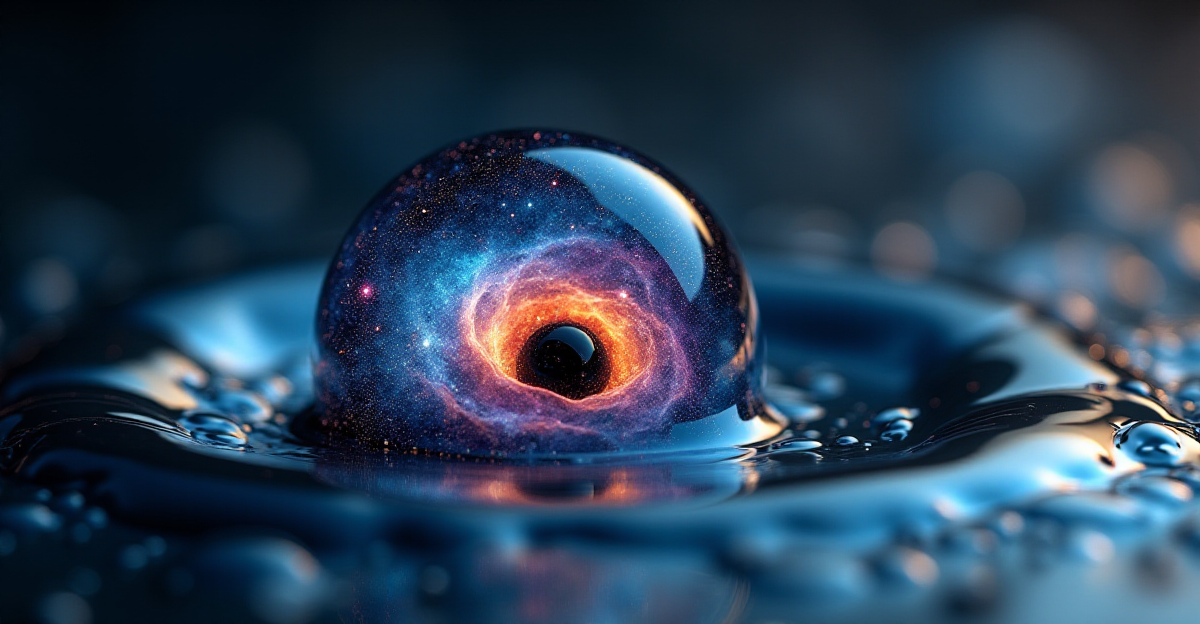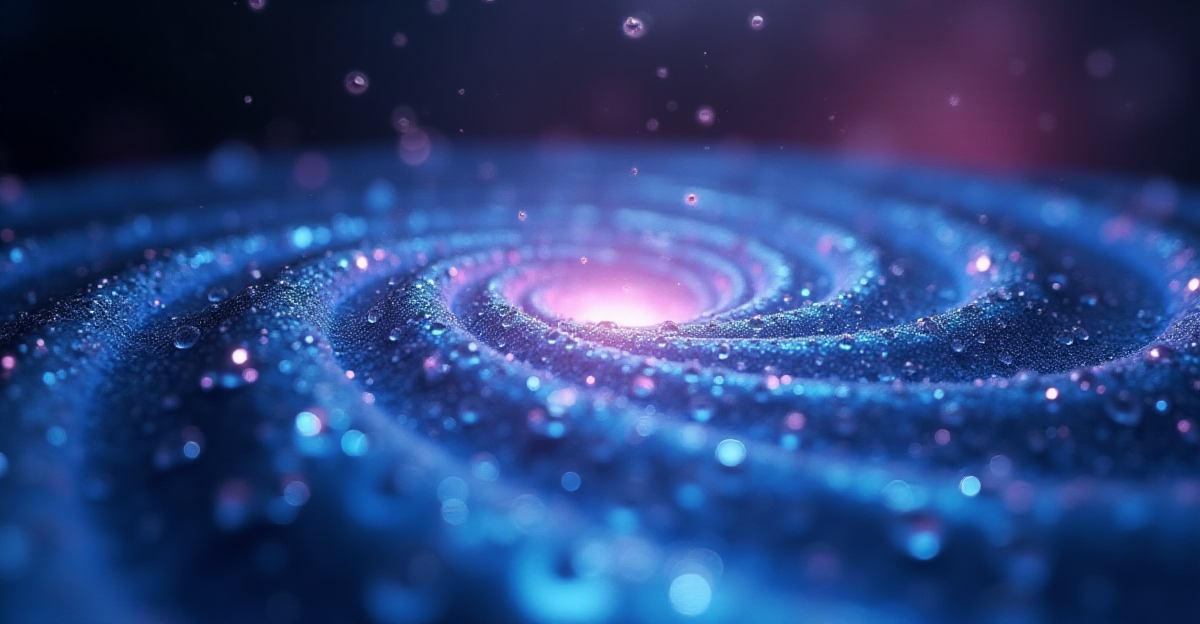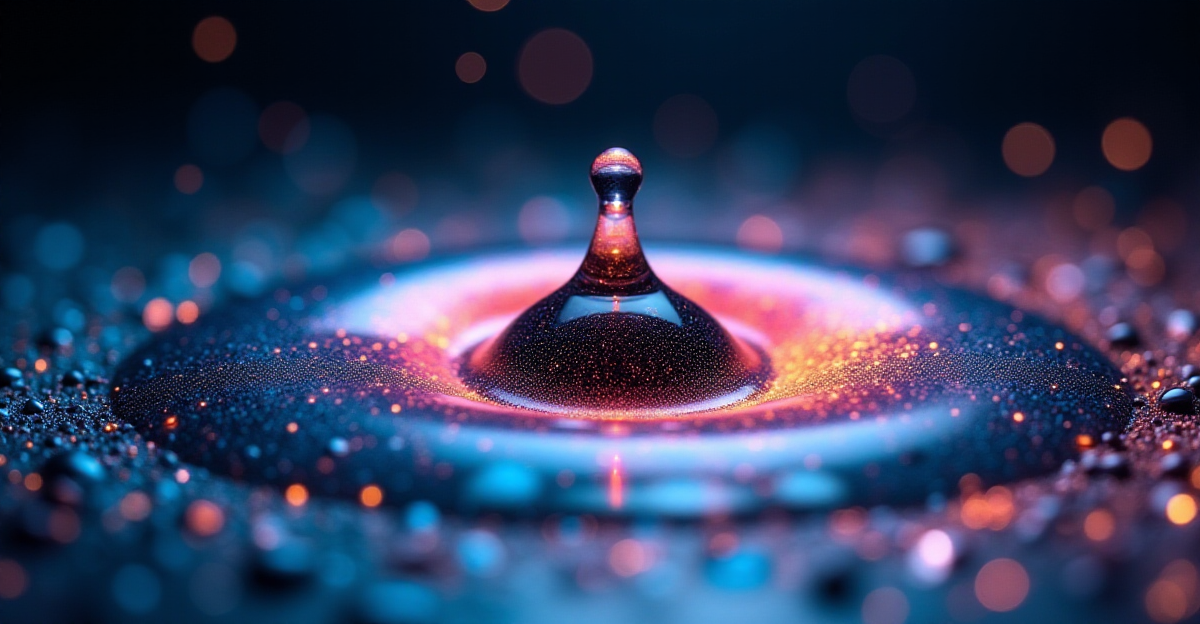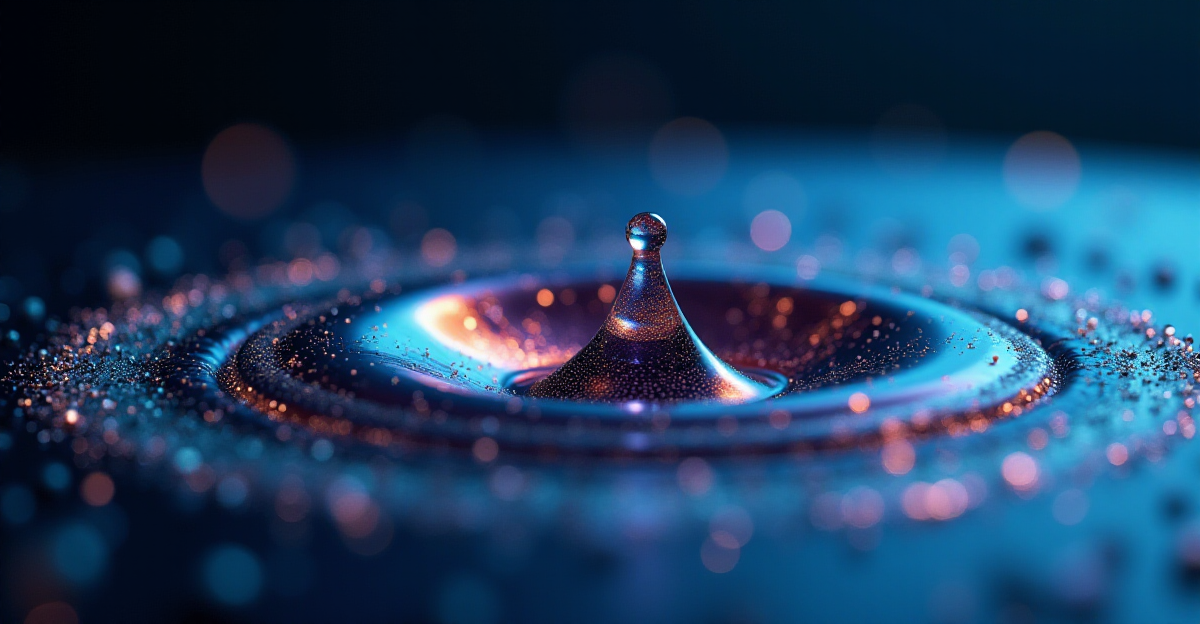Using common liquids, the developing discipline of quantum fluid holography helps researchers investigate gravitational events. By means of my study on quantum fluids, I have investigated how these systems could act as analogues for comprehending intricate cosmic events. Deep relationships between quantum fluids and gravitational systems are suggested by the holographic principle. Recent studies have shown how features of black hole physics might be simulated via quantum fluid dynamics. Analogous Hawking radiation seen in these fluid systems has given scientists understanding of quantum gravity. Without the need for large-scale telescopes, the technique lets cosmic events be studied in laboratory settings. By means of these tests, quantum physics and gravity are being bridged. The field shows how apparently distinct physical systems might display universal tendencies. The work affects knowledge of both basic physics and useful fluid dynamics.
Table of Contents
- Universe in a Droplet
- Universe in a Droplet: Fluid Dynamics Meets Gravity
- Universe in a Droplet: Fluid Dynamics Meets Gravity
- Extra’s:
Universe in a Droplet

Imagine staring into a small liquid droplet and seeing the expanse of space and black hole echoes. This is the intriguing universe of quantum fluid holography, not science fiction. This novel discipline mimics complicated quantum gravity events by means of the behavior of common liquids. Investigating this surprising link between quantum fluids and gravity systems, my studies reveal its very amazing potential. The holographic principle, a theory implying a great correlation between apparently different fields, lays the theoretical basis. This idea is not only theoretical; tests show that quantum fluid holography offers a strong quantum simulation tool able to replicate features of black hole physics in a controlled laboratory environment. Studying the fluid dynamics of these systems helps us to understand some of the most important secrets of the cosmos and opens fascinating new directions of scientific exploration. Within a lab environment, we are building thorough models of very powerful astrophysical phenomena. This method lets us test hypotheses in creative ways by providing a degree of accuracy and control formerly unthinkable. This greatly enhances our knowledge of other basic features of physics like quantum gravity. The approach consists in meticulous manipulation of quantum fluids under exact control over variables including temperature, pressure, and density. These well selected settings enable us to replicate particular characteristics of black holes and other quantum gravity associated events. After that, the obtained data can be examined and matched with theoretical projections to improve our knowledge even more. We also use cutting-edge computational methods to replicate and model the recorded events, therefore offering a whole view of the mechanisms engaged. Condensed matter physics, fluid dynamics, and theoretical physics are among the disciplines that this multidisciplinary approach calls for knowledge of. This work has consequences outside of cosmology and theoretical physics.
Unlocking the Secrets of Black Holes through Analogues
Unprecedented prospects arise from the capacity to generate black hole analogues in the lab using quantum fluid holography. Under controlled circumstances, we can see events like Hawking radiation, usually connected to black holes,. This laboratory cosmology provides a degree of precision and control unthinkable few years ago, therefore avoiding the great difficulties of celestial observation. Researchers have, for instance, effectively found analogues of Hawking radiation in superfluids, therefore verifying theoretical predictions and stressing the relevance of this method. These tests directly investigate the behavior of matter under highly demanding circumstances, therefore offering important new perspectives on the basic rules controlling the cosmos. Additional investigation on this subject will help us to better grasp the physical mechanisms underplay surrounding black holes. Investigating the intricate interplay among gravity, quantum physics, and thermodynamics close to these very dense areas is part of this also. Moreover, a better knowledge of the fluid dynamics involved would enable us to create more exact and sophisticated models for both theoretical and experimental uses. Improved designs and simulations of extreme astrophysical systems can follow from this in turn. We are always striving to improve our methods to produce more intricate and realistic black hole simulations including ones with spin or charge. This will enable us to better polish models for several astrophysical events and investigate their behavior under a broad spectrum of conditions.
The Future of Quantum Fluid Holography and its Advancements
The shared universal characteristics of apparently different systems—the microscopic world of quantum fluids and the macroscopic universe—are succinctly shown by quantum fluid holography. We construct simplified quantum simulations that clarify the behavior of black holes and other cosmic events by analyzing the fluid dynamics of especially constructed quantum fluids. This method offers a strong instrument for practically exploring the holographic principle and highly precisely evaluating theoretical predictions. We advance toward a unified theory explaining the interior operations of the universe by closing the distance between quantum gravity and quantum mechanics. This discipline marks a major development since it provides a strong fresh experimental foundation for investigating basic physics. Investigating more difficult black hole situations—including those requiring spin or charge—is the next phase. We also wish to explore the limits of this method and challenge its applicability. Along with enhancing the realism of the simulations themselves, this research entails creating more exact methods for measuring and regulating the pertinent factors. Future studies in this topic should concentrate on improving the methods, investigating even more difficult situations and increasing the spectrum of events that could be replicated. There are many possible uses and discoveries in this subject ahead. We are eager to learn what new insights quantum fluid holography may expose about the universe as the path of discovery is continuous.
Universe in a Droplet: Fluid Dynamics Meets Gravity

Ever wonder if something as basic as a droplet of liquid might conceal the largest secrets of the cosmos, including black holes and whirling nebulae? That sounds absurd, right? Still, quantum fluid holography is based on a fantastic concept. We replicate complicated gravitational events using the behavior of ordinary liquids, therefore simulating a small universe in a laboratory! Deeply exploring this intriguing junction between the microscopic realm of quantum fluids and the enormity of quantum gravity is my team and me. We are operating controlled environments to observe how black holes and other cosmic occurrences behave. This allows us to test hypotheses, enhance models, and perhaps even quite precisely expose some of the darkest secrets of the universe. Discovering a secret code to the cosmos encoded in atom movement is like Unbelievably, the way atoms migrate in these quantum fluids reflects the great cosmic dance of stars and galaxies. This link could alter all we now understand about cosmology and fluid dynamics. Though the labor is difficult, the possible discoveries make it immensely satisfying. We are always honing our methods and strengthening our analysis to investigate increasingly more challenging circumstances. We are continuously stretching the envelope of possibility.
Simulating Black Holes: A New Frontier in Laboratory Cosmology
A major advance is the capacity to generate black hole analogues from quantum fluid holography. Imagine being here in our lab able to investigate events like Hawking radiation, something often only seen with strong telescopes! This laboratory cosmology provides hitherto unheard-of degree of control. Without the constraints of seeing far-off galaxies, we may accurately change variables including temperature, pressure, and density to investigate extreme gravity, what happens to matter near a singularity, and the subtleties of spacetime curvature. This simplifies things greatly since we can readily test theoretical predictions. We replicate what we see using advanced computer technologies. For one experiment employing superfluid helium-4, for instance, we observed analog Hawking radiation, therefore verifying theoretical expectations. To create even more accurate simulations, we are including more elements and experimenting with several quantum fluids. This exacting method enables us to extract important data and greatly advance our theoretical knowledge of black holes and quantum gravity. We are continuously improving our models by include spin and charge to provide a more whole view of how black holes behave under different circumstances. It’s like creating in our lab a thorough 3D model of a black hole.
Quantum Fluid Holography and its Wider Implications
More than a simulation, quantum fluid holography exposes universal ideas controlling both small and large systems. The holographic principle—that the information of a volume of space is stored on its boundary—suggests a close relationship between quantum fluids and quantum gravity. Examining the fluid dynamics of these quantum fluids helps us not just to produce simplified black hole models but also provides understanding of spacetime itself. This method might result in a single theory tying together apparently separate spheres of physics. And the possible uses transcends cosmology as well. Knowing the fluid dynamics of these systems might enable design of novel materials with amazing characteristics in materials science. Imagine building superconductors functioning at ambient temperature or materials stronger than steel! In engineering, this could produce more effective tools. We are working for increased accuracy in our simulations and investigating increasingly complicated black hole situations. With quantum fluid holography, we are also extending the spectrum of events we may investigate and creating sophisticated measuring methods. It’s amazing to consider how this science might transform the planet.
Universe in a Droplet: Fluid Dynamics Meets Gravity

Imagine staring inside a tiny liquid droplet and seeing the great expanse of space and the faint echoes of black holes. This is the amazing universe of quantum fluid holography, not science fiction. This discipline reveals the unexpected link between the macroscopic universe under quantum gravity and the microscopic world of quantum fluids, therefore transforming our knowledge of the cosmos. Using methods from fluid dynamics to replicate some of the most dramatic and mysterious events in the universe, we are effectively building a laboratory cosmology. With hitherto unheard-of control and accuracy, this method lets us investigate black holes, Hawking radiation, and other cosmic events. In quantum fluids, the possibility to precisely test theoretical predictions and improve current quantum gravity models arises from the capacity to finely modify parameters including temperature, pressure, and density. All inside a well under control laboratory setting, we may investigate spacetime curvature and the behavior of matter under strong gravitational pressures. This marks a paradigm change bridging the theoretical physics gap with experimental confirmation. Condensed matter physics, fluid dynamics, and theoretical physics are combined in this multidisciplinary subject to reveal the most secret nature has. The continual developments in computational models and experimental methods are stretching the possibilities in this subject. The possibility for ground-breaking revelations really motivates us. The capacity of this approach to make the complexity of quantum gravity controllable and experimentally verifiable determines its strength.
Simulating Black Holes and Hawking Radiation
Laboratory cosmology now has fresh directions thanks to the development of black hole analogues utilizing quantum fluid holography. Under carefully regulated conditions, we can detect events like Hawking radiation—usually connected with black holes—by exactly controlling quantum fluids. With an unparalleled degree of control and accuracy, this method overcomes the great observational obstacles related with astronomical studies of genuine black holes. Direct validation of theoretical predictions and the power of this novel approach has come from successful observations of analogues of Hawking radiation in superfluids. This method helps to investigate the behavior of matter under very strong gravitational conditions, therefore offering important new perspectives on the basic rules of the cosmos. By quantum simulation, we can investigate the intricate interaction of thermodynamics, quantum physics, and gravity close to these very dense areas. We can look at the minute aspects of spacetime curvature in ways before thought unworkable. More exact and sophisticated models for both theoretical and experimental uses can be developed by means of a better knowledge of the fundamental fluid dynamics. Using spin and charge, my team constantly improves these experimental methods to create more complex and realistic black hole simulations. This helps us to carefully test theoretical models with extraordinary precision, hence improving our knowledge of black holes and quantum gravity. Great care is used in analyzing the experimental data and matching it with theoretical projections helps us to better grasp things. Advanced computational modeling methods improve this approach, therefore raising the precision of our results and significantly advancing our knowledge of black hole physics and quantum gravity. We are basically reproducing in a laboratory environment exact simulations of extreme astrophysical phenomena, therefore offering a degree of precision and control before unthinkable.
The Holographic Principle and Its Implications
The shared universal characteristics of apparently different systems—the microscopic world of quantum fluids and the macroscopic universe—are succinctly shown by quantum fluid holography. The holographic principle—the theory that the boundary of a volume of space stores its information content—suggests a close relationship between these worlds. Imagine a three-dimensional item whose whole description is contained on a two-dimensional surface, much as a hologram. Comparably, the holographic principle holds that the information of the cosmos is contained inside its boundaries. Simplified quantum simulations highlight features of black holes and other cosmic events by means of examining the fluid dynamics of especially engineered quantum fluids. This method not only provides a strong instrument for experimentally examining the holographic principle, but also enables us to test theoretical predictions with very great accuracy. We essentially use a complicated system—the universe—to improve our grasp of a simpler system—a droplet of liquid—and vice versa. This method closes the distance between quantum gravity and quantum mechanics, therefore guiding us toward a single theory to clarify the inner dynamics of the cosmos. Beyond cosmology, quantum fluid holography has ramifications; knowledge of the fluid dynamics of these systems could propel developments in many disciplines, including the construction of new materials with particular qualities. For instance, knowledge of fluid behavior under extreme conditions might inspire the development of fresh kinds of superconductors or materials with improved heat transmission capacity. Refining experimental methods, investigating more difficult situations, and extending the spectrum of events we can replicate with quantum fluid holography is the main emphasis of current work. There are really rather many possible uses and discoveries here.
Extra’s:
For a deeper dive into the fascinating world of quantum precision and its applications, you might be interested in our post on “Phononic Frequency Combs: Sound Waves Meet Quantum Precision,” which explores another area where precise measurements are crucial. This post delves into the intricacies of manipulating sound waves with remarkable accuracy, a concept that shares similarities with the controlled manipulation of quantum systems crucial to understanding holographic principles, as discussed in our current article. Similarly, the delicate balance and precise control needed to study the quantum phenomena described in “Edge States in Topological Superconductors: Dancing with Majorana Zero Modes” echoes the challenges and rewards of simulating complex systems like black holes using quantum fluids. Understanding these intricate systems provides crucial insight into the complex interplay between quantum mechanics and macroscopic phenomena. Both articles offer further examples of how advanced techniques are revealing the secrets of the quantum realm.
To expand your understanding of the holographic principle beyond the scope of this article, you may find the Quora discussion “How can experimental physicists prove the Holographic Principle? – Quora” insightful. This external resource provides diverse perspectives on the experimental verification of the holographic principle, a concept central to our exploration of black hole simulation. Furthermore, for a more comprehensive historical and theoretical overview, the scholarly article “Analogue gravity and the Hawking effect: historical perspective and literature review | The European Physical Journal H” offers an extensive examination of analogue gravity, providing valuable context for the experimental methods discussed within the blog post. These external links offer supplementary information and different approaches to comprehending the intricate concepts at play, broadening your understanding of the broader field of quantum fluid holography and its implications.












1 thought on “Quantum Fluid Holography: Simulating Black Holes in a Droplet”